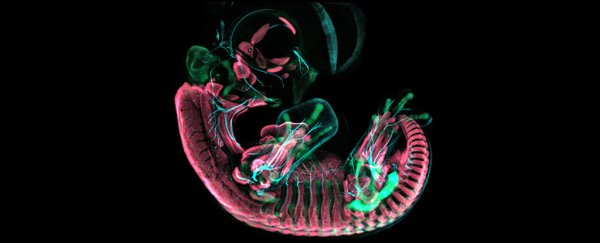In spite of their reputation as living dinosaurs, birds have come a long way since the days of T. rex and friends.
Gone is the toothy rostrum, replaced by the more familiar beak. Their skeletons have adapted for flight, as have their forelimbs. Even their pelvis is twisted into a shape that their more ancient ancestors would barely recognize.
These changes weren't spontaneous developments, nor are they absolute. For a brief period early in their development, in fact, birds of all variety grow a pelvis that wouldn't have looked out of place as part of a fossilized dinosaur's skeleton.
As a part of an ongoing investigation into the way common ancestors to reptiles, birds, and dinosaurs evolved their characteristic features over the eons, researchers from across the US mapped the fetal development of crocodilian and avian skeletons.
They found the pelvis is an example of what's known as a terminal addition – a characteristic that starts off remarkably conserved, resembling a structure associated with their ancestors, before morphing into a more novel shape later in an individual's development.
"It was unexpected to find these initial stages of bird development look so much like the hips of an early dinosaur," says Christopher Griffin, an evolutionary biologist from Yale University with a particular interest in the history of vertebrates.
"During just two days, the developing embryo changes in a way that reflects how they changed in evolution, transitioning from looking like an early dinosaur to looking like a modern bird."
Buried deep inside the abdomen, the pelvises of reptiles, birds, and dinosaurs aren't the first thing that stands out as quintessentially different between these three branches of the vertebrate tree.
 Pelvic bones of reptiles, dinosaurs, and birds. (Griffin et al., Nature, 2022)
Pelvic bones of reptiles, dinosaurs, and birds. (Griffin et al., Nature, 2022)
Considering the distinctness of their methods of locomotion – from the lizard splayed out on a rock, to the majestic stride of a hunting theropod, to the Mick Jagger strut of a chicken – it's not hard to imagine the kinds of changes required of their bones and muscles.
Bird femurs are more horizontal than those of any dinosaur, for example, allowing their lower legs to carry their movement.
To accommodate changes to their movement style, their ilium (our hip bones) extends more towards their chest and bum, carrying their body's bulk; their pubic bone tilts backwards rather than faces forward, with the pubis bones left wide open.
On top of all of these skeletal changes, ligaments, muscles, and tendons also had to undergo significant redesigns without compromising the movements of the animal.
Watching the way a growing organism builds its body from scratch can provide insights into the way evolution might tinker with an ancestor's blueprints to innovate.
So Griffin and his team used fluorescing antibodies to highlight skeletal development in the embryos of several bird species, including domestic chickens and budgerigar parakeets, as well as alligators.
Using CT scans to build 3D models of the growing bones, muscles, nerves, and connective tissues, the researchers mapped the changes in morphology from early in development through to hatching.
The bird-like adaptations of the pelvic skeletal and muscular system, they found, appeared far later in development than expected, emerging from features that all looked more at home in a dinosaur's body.
"Every single bird, in its early life, possesses this dinosaurian form," says Yale vertebrate paleontologist Bhart-Anjan S. Bhullar.
"Then, at the last minute, it's like it remembers it's a bird and needs a bird's pelvis."
Finding an example of a terminal addition representative of a whole class of organisms is a big discovery, one that had previously only been debated as possible.
Given the fact the muscles and bones of the hips all needed to evolve together to do their job effectively, it might not be surprising to find they develop in this way.
The researchers think there could easily be other cases of terminal addition worth looking for across large groups of organisms, and could even be common across major evolutionary transitions.
For dinosaur enthusiasts, it's fascinating knowing that Jurassic Park is only ever as far away as a fertilized chicken egg.
This research was published in Nature.
